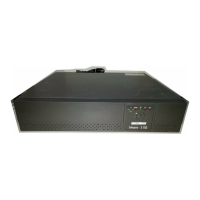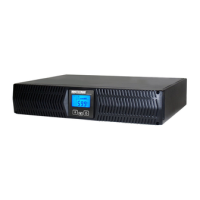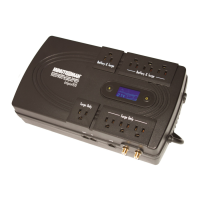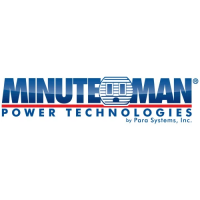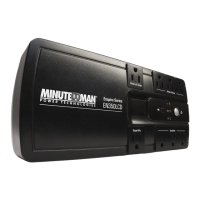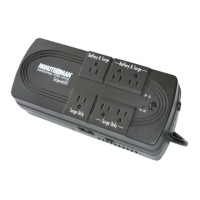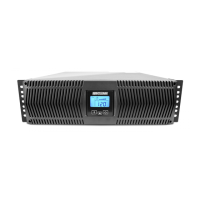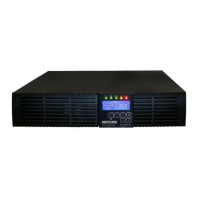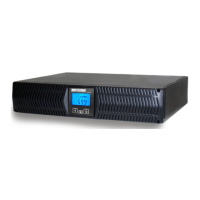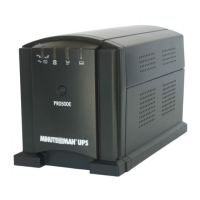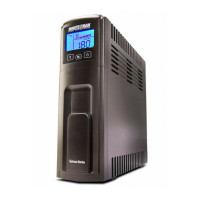Do you have a question about the Minuteman Enterprise Plus Series and is the answer not in the manual?
Crucial safety guidelines and warnings to be followed during installation and operation.
Procedure for inspecting the UPS for shipping damage and notification steps.
Description of the UPS front panel, including LEDs and buttons.
Explanation of bar graph LEDs indicating load capacity and battery status.
Details on how to operate the UPS power and self-test functions.
Identification and function of all ports and connectors on the UPS rear panel.
Guidelines for selecting an appropriate installation location and environmental conditions.
Step-by-step procedure for connecting the internal UPS batteries.
Instructions for installing the UPS into a standard 19-inch or 23-inch equipment rack.
Method for setting up the UPS in a vertical tower orientation.
Method for setting up the UPS in a horizontal desktop orientation.
Procedure for securely mounting the UPS unit onto a wall.
Steps for connecting the UPS to an AC source and connecting your equipment.
Guidance on connecting communication ports, phone lines, and network protection.
Explanation of the UPS's line-interactive function and Automatic Voltage Regulation (AVR).
Instructions for powering the UPS on, off, and the associated button functions.
Details on self-testing, dipswitch configuration, and load shedding capabilities.
Understanding UPS alarms, low battery warnings, overloads, and fault conditions.
A table identifying common symptoms, their possible causes, and recommended solutions.
Step-by-step guide and essential safety precautions for replacing UPS batteries.
How to contact technical support, warranty claims, and return procedures.
Detailed technical specifications for system, input, and output operations.
Specifications related to the battery system, surge protection, environment, and physical dimensions.
Information on safety standards and certifications met by the UPS.
User-configurable settings for UPS ID, auto-restart, alarms, and output voltage.
Details of the limited product warranty, coverage, exclusions, and liability.
Formal declaration of the equipment's compliance with relevant EU directives and standards.
Crucial safety guidelines and warnings to be followed during installation and operation.
Procedure for inspecting the UPS for shipping damage and notification steps.
Description of the UPS front panel, including LEDs and buttons.
Explanation of bar graph LEDs indicating load capacity and battery status.
Details on how to operate the UPS power and self-test functions.
Identification and function of all ports and connectors on the UPS rear panel.
Guidelines for selecting an appropriate installation location and environmental conditions.
Step-by-step procedure for connecting the internal UPS batteries.
Instructions for installing the UPS into a standard 19-inch or 23-inch equipment rack.
Method for setting up the UPS in a vertical tower orientation.
Method for setting up the UPS in a horizontal desktop orientation.
Procedure for securely mounting the UPS unit onto a wall.
Steps for connecting the UPS to an AC source and connecting your equipment.
Guidance on connecting communication ports, phone lines, and network protection.
Explanation of the UPS's line-interactive function and Automatic Voltage Regulation (AVR).
Instructions for powering the UPS on, off, and the associated button functions.
Details on self-testing, dipswitch configuration, and load shedding capabilities.
Understanding UPS alarms, low battery warnings, overloads, and fault conditions.
A table identifying common symptoms, their possible causes, and recommended solutions.
Step-by-step guide and essential safety precautions for replacing UPS batteries.
How to contact technical support, warranty claims, and return procedures.
Detailed technical specifications for system, input, and output operations.
Specifications related to the battery system, surge protection, environment, and physical dimensions.
Information on safety standards and certifications met by the UPS.
User-configurable settings for UPS ID, auto-restart, alarms, and output voltage.
Details of the limited product warranty, coverage, exclusions, and liability.
Formal declaration of the equipment's compliance with relevant EU directives and standards.
| Humidity | 0-95% Non-Condensing |
|---|---|
| Display | LCD |
| Dimensions | Varies by model |
| Weight | Varies by model |
| Form Factor | Tower |
| Input Frequency | 60 Hz |
| Output Frequency | 60 Hz |
| Efficiency | 95% |
| Battery Type | Sealed Lead Acid |
| Typical Recharge Time | 8 Hours |
| Operating Temperature | 0°C to 40°C |
| Storage Temperature | -15°C to 45°C |
| Communication Ports | USB |
